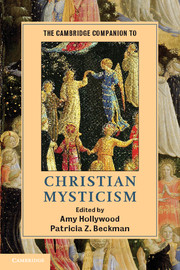Book contents
- Frontmatter
- Contents
- Contributors
- Introduction
- Part I Contexts
- 1 Early Monasticism
- 2 Song, Experience, and the Book in Benedictine Monasticism
- 3 New Forms of Religious Life in Medieval Western Europe
- 4 Early Modern Reformations
- Part II Key Terms
- Part III Contemporary Questions
- Select Bibliography of Christian Mystical Texts up to around 1750
- Select Bibliography of Modern Works Related to the Study of Western Christian Mysticism
- Author and Artist Index
- General Index
- References
3 - New Forms of Religious Life in Medieval Western Europe
from Part I - Contexts
Published online by Cambridge University Press: 05 December 2012
- Frontmatter
- Contents
- Contributors
- Introduction
- Part I Contexts
- 1 Early Monasticism
- 2 Song, Experience, and the Book in Benedictine Monasticism
- 3 New Forms of Religious Life in Medieval Western Europe
- 4 Early Modern Reformations
- Part II Key Terms
- Part III Contemporary Questions
- Select Bibliography of Christian Mystical Texts up to around 1750
- Select Bibliography of Modern Works Related to the Study of Western Christian Mysticism
- Author and Artist Index
- General Index
- References
Summary
Sometime in the early years of the eleventh century, a young Italian monk, called “Little John” because of his small stature, left his homeland to seek the true religious life in France. John traveled north at the invitation, we think, of his compatriot William of Volpiano, who in 987 entered the Benedictine monastery of Cluny in Burgundy, from there reformed Saint Bénigne of Dijon, and then founded Fruttuaria, the leading Cluniac house in northern Italy. Little John joined William at Saint Bénigne, which in the following years served as their basis for a wide-ranging renovation of monastic life in central and northern France. At the behest of Duke Richard II of Normandy, the two moved to Fécamp, where John became prior in 1017. He assumed the abbacy in 1028 and remained at the helm of Normandy’s most prestigious monastery until his death fifty years later.
Abbot John of Fécamp, as he is known today, embodies in many ways the best of traditional Benedictine monasticism. A tireless administrator and disciplinarian, he solidified Fécamp’s land holdings, took charge of Saint Bénigne along with his own abbey when the former experienced a leadership crisis, and reformed two other monasteries. An earnest scholar, John expanded Fécamp’s school and library – in the 1070s, the library possessed eighty-seven manuscripts, virtually all acquired during his abbacy. He advised King William of Normandy, served a pope, and counseled an empress. He traveled to Jerusalem at a time when few Westerners ventured there. Amidst all that executive and inner-worldly action, he wrote extensively on the central, contemplative duties of the monk, offering a Lament on Lost Leisure and Solitude in which he longed for “the chaste and pure solitude, the sea of peace and rest where one enjoys intimacy with God.”
- Type
- Chapter
- Information
- The Cambridge Companion to Christian Mysticism , pp. 80 - 113Publisher: Cambridge University PressPrint publication year: 2012
References
- 2
- Cited by

